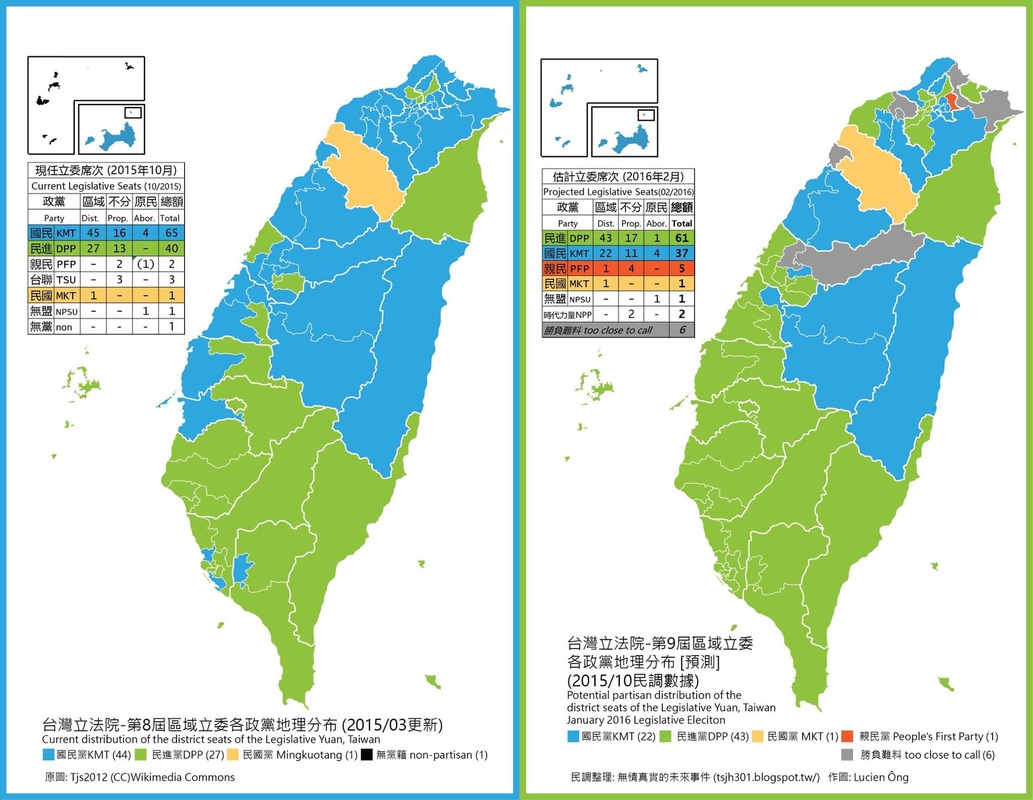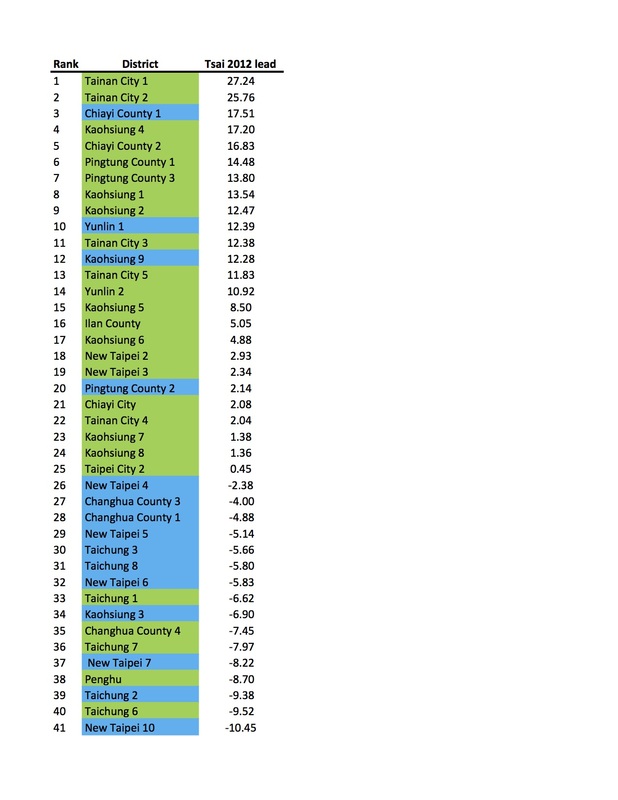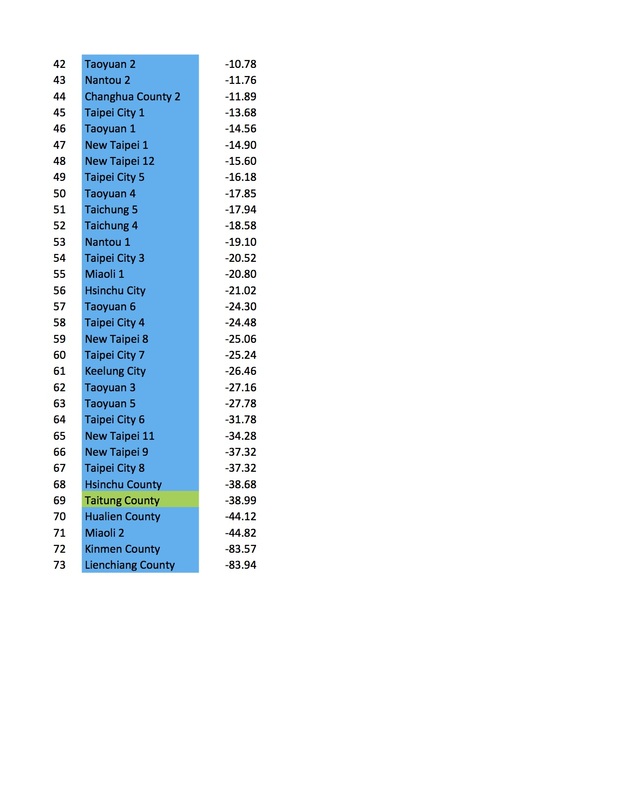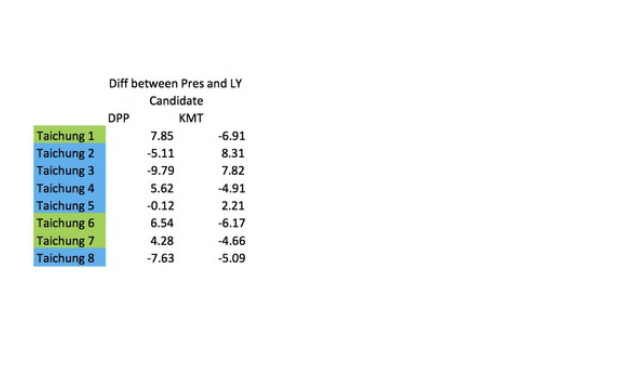The race for the presidency in Taiwan appears all but over already: Tsai Ing-wen is going to win and it isn't going to be very close. What's both more uncertain and more challenging to forecast is what will happen in the legislative elections. I've seen some analyses that start with the results of each district race in 2012 as a baseline, then projects up from those results to estimate how many more seats the DPP will win with a particular partisan swing.
To me, the better place to start this kind of forecasting is with the 2012 presidential results in each district, when Tsai Ing-wen ran against Ma Ying-jeou and James Soong. The idea here is, put aside idiosyncrasies such as intra-camp splits and candidate quality, and just pit a generic DPP candidate for the legislature against a generic KMT one in a head-to-head competition. Then who should we expect to win? That's what the presidential results by district tell us. (This measure is roughly analogous to the Partisan Voter Index that the Cook Report does for the US every election cycle.)
A measure of "partisan balance" based on presidential election results is conceptually simple and straightforward, but it's also a bit of a pain to construct because in Taiwan the official data sources don't present presidential results in this way. In some cases (e.g. Taipei, Kaohsiung, and Taoyuan) the legislative boundaries divide municipal districts in two, so figuring out an LY district's partisan balance in many cases requires some tedious aggregation of presidential results up from the township or district, or even the li (里) level.
I haven't seen district-level presidential results available online anywhere, so as a public service I'm posting them in the excel file below, so that anyone who wants to can play around with the numbers.
(The source data, of course, are from the ROC Central Election Commission's elections database.)
| taiwan_2012_presidential_and_ly_elections_compared.xlsx |
With the district-level results in hand, we can rank-order all 73 single-member districts* by the difference between the vote share won by the two camps in the presidential race (Tsai - (Ma+Soong)). I've also color-coded each district by which party currently holds the seat: green for the DPP, blue for the KMT. (For simplicity's sake I've just colored the two pan-blue independents--in Lienchiang and now in Hsinchu County--blue as well.)
The full list is below. At the top is Tainan City 1, the district with the strongest lead for Tsai--the greenest, in Taiwan politics parlance. in 2012 Tsai won here 63.62% to 34.05% for Ma and 2.33% for Soong, for a net difference of 27.24. By this measure of partisan balance, this is the hardest district for a KMT candidate to win in the country. On the other end of the spectrum is Lienchiang County--Matsu--where Tsai won only 8.03% of the vote, compared to 86.81% for Ma, and 5.36% for Soong. No surprise here: Lienchiang and Kinmen (right above it) are the two hardest districts for a DPP candidate to win.
A few observations follow after the break.
1. In 2012, KMT LY candidates did not run ahead of Ma Ying-jeou.
In fact, they ran behind. The belief that KMT legislative candidates on average outperform the person at the top of the ticket seems to be widespread; it's also simply wrong. Look how closely the legislative results track Tsai's margin of victory in the district. The KMT won only four seats in districts where Tsai won a majority: Chiayi County 1, Yunlin 1, Kaohsiung 9, and Pingtung 2. Note what happens when we cross over from the last district Tsai won (Taipei City 2) to the first she didn't (New Taipei 4): a lot more blue appears. With four exceptions, the KMT legislative candidates only won in districts that Ma Ying-jeou also won.
What of the exceptions? In fact, the number of districts that voted for the presidential candidate of one party camp but a legislative candidate of the other nearly cancel each other out, and actually favor the DPP slightly: the KMT has 4 to the DPP's 6. In other words, the KMT's current Legislative Yuan majority is not built on a "performance gap" with the DPP that comes from widespread ticket-splitting, but on the generic partisan balance of the districts.
Can we quantify this difference? Of course. Take all districts in which there was both a KMT and DPP candidate in the race. Here's the average difference between the LY and presidential candidates across all 73 districts:
- DPP: -1.06. That is, Tsai got 1.06% more than DPP candidates across all districts.
- KMT: -4.37. Ma got 4.37% more than the average KMT candidate.
- DPP: -0.86.
- KMT: -3.07.
- DPP: -0.86%. Across all two-party fights, Tsai got 0.86% more than DPP candidates on average.
- KMT: -2.98%. Ma got 2.98% more than KMT candidates.
In a word: wow. This was not what I expected. (Especially given what the Frozen Garlic blog, for which I have tremendous respect, has written about this.) Even when we take third-party candidacies out of the picture, DPP LY nominees actually did better on average than their KMT opponents relative to the presidential race. And this isn't even accounting for incumbency advantage: given that there were many more KMT incumbents running in 2012, KMT candidates on average should be running ahead of Ma Ying-jeou**, or at least closer to their standard-bearer than their DPP opponents. There's no evidence here that they did. KMT LY candidates did not benefit from a "performance gap" over their presidential candidate, or even over generic DPP candidates, once we account for the partisan balance of the districts.
The takeaway here is that if 2016 is anything like 2012, there is simply not going to be enough split-ticket voting to save KMT candidates if their districts vote for Tsai Ing-wen. The size of Tsai's margin of victory is probably going to decide whether the DPP wins a majority.
2. Tsai's "magic number" for a DPP majority is about 57% of the popular vote.
If in 2016 there is a similar correlation between vote shares for Tsai in the presidential race and for the DPP candidates in the LY races, then it's simple to figure out just how much of an improvement over 2012 Tsai needs in order to deliver a DPP majority. The DPP currently holds 27 district seats, and it is forecast to win about 16 PR seats, so it needs to flip a net of 14 additional seats to get to 57 (out of 113 total.)
If we assume that the Taitung seat (sorry, Liu Chao-hao!) will revert to the pan-blue camp, then the DPP needs to flip 15 seats. Going down the ranking by Tsai's margin of victory in 2012, the 15th KMT-held seat (and 41st overall) is New Taipei 10, which Tsai lost by 10.45%. She got 45.63% of the total vote then; a 10.45% improvement over that would be 56.08%. If we assume that the 0.86% lead Tsai had over the average DPP candidate in 2012 will be repeated, and there's a uniform swing (both big assumptions, admittedly), then the magic number for a DPP LY majority is about 57%.
We can also estimate how the legislature will break down at numbers below or above this point. The go-to website for aggregated polls right now has Tsai winning 58.7% of the vote. That's an increase of 13.07% above 2012, which would deliver up through Changhua 2 (#44 on the list). In this scenario the DPP would win 60 seats--still not a large majority, in fact, and nothing near the KMT's 81 seats in 2008, which is a stark indication of how disproportionality in the current system favors the pan-blue side. What if Tsai won only 8% more than she did in 2012 (53.63% of the total vote)? Then the DPP could expect to win 36 district seats and around 52 seats overall, leaving it 5 seats short of a majority; in that case, it might be able to forge a pan-green majority by leaning on the NPP (3-4 seats) and an independent or two, depending on how the PR and intra-pan-blue races shake out. (Note again that I'm assuming 16 PR seats for the DPP, which is what the KMT holds right now.)
3. If the DPP wins a majority, it'll need to win big in New Taipei and Taichung.
If you look closely at the list, a majority of the most competitive districts are actually concentrated in just two cities: New Taipei (4, 5, 6, 7, and 10) and Taichung (2, 3, and 8, plus DPP incumbents in pan-blue-majority districts in 1 and 6). Before I started this exercise I had expected Taoyuan to be more important, but this ranking shows that if the DPP wins Taoyuan 1 or 4, then it's probably already secured a majority in the LY. If I were the KMT, I'd be focusing all my efforts on these two areas: that's where the battle for the legislature will be decided, and that's where the allocation of scare electoral resources might actually make a difference.
An important side note about Taichung: in 2012 there was a LOT of ticket-splitting here compared to the rest of the island. Take a look at the table below. DPP candidates ran at least 5 points ahead of Tsai in Taichung 1, 4, and 6, and 4.28% ahead in Taichung 5; KMT candidates ran at least 5 points ahead in Districts 2 and 3, and 2.21% ahead in 5. Those deviations suggest that the personal vote--candidates' personal characteristics, and their factional ties--was more important here than elsewhere. That's something to look out for in 2016: the personal appeal of candidates and factional politics rather than the swing to Tsai could decide how the Taichung races play out, and thus decide whether the DPP wins a majority in the Legislative Yuan.
The major bugaboo in basing predictions on partisan swings is the possibility of splits within either of the two major camps. In this election cycle, both the DPP and KMT have faced this threat. The DPP has done much better at managing it. It's entered into an informal cooperation arrangement with the upstart New Power Party, yielding several districts to NPP candidates and not nominating its own candidates there. It's done the same with other minor parties in individual cases; it endorsed Huang Shan-shan (黃珊珊) of the PFP in Taipei 4, Fan Yun (范雲) of the SDP-Green Party alliance in Taipei 6, and Liu Kuo-lung (林國隆) of the TSU in Taichung 5, among others.
For the most part, the kinds of districts the DPP has yielded are the right ones to give up in this environment: they're not near the crucial 41st seat in the ranking above, so control of the majority in the LY likely won't depend on the outcomes of those races. The one exception is in Taichung 3 (#30 on the list), which the DPP yielded to Hung Tzu-yung (洪慈庸) of the NPP. This was probably necessary to ensure that the NPP would abide by the cooperation agreement and not run renegade candidates in other competitive districts; I've heard that the NPP is placing a high priority on winning at least one district seat, above and beyond what it gets in the PR list. So if that's true, then the DPP got a pretty good deal: one competitive seat for cooperation everywhere else. But it does make the path to a single-party majority slightly more difficult.
But if you want to see real problems, look at the KMT. Thanks in part to the party's sinking popularity over the last two years and the twists and turns in its nomination of a presidential candidate, the ruling party has failed to adopt coordination agreements with other pan-blue groups, and KMT nominees are facing renegade pan-blue candidates in a lot of districts. A prominent case is in Keelung, where former Taipei mayor Hau Lung-pin (郝龍斌) parachuted in as the official nominee without doing a lot of prep work beforehand. Despite his prominence, he failed to clear the field of opponents from the pan-blue camp: he now faces challenges from the PFP's Liu Wen-hsiung (劉文雄), that party's deputy secretary-general, and the Min-Kuo-Tang's (MKT) Yang Shih-cheng (楊石城). On the list above, Keelung is all the way down at #61: in 2012 Ma outpolled Tsai by a whopping 26.45%. It should not be competitive. But now Hau is reportedly in a major electoral fight that's expected to go down to the wire, and the DPP candidate could sneak out a win there.
It's a similar story elsewhere around the island. Districts that are deep blue and would not be at all competitive under a pan-blue coordination agreement, such as Taipei 4, Taoyuan 5, and Hsinchu County, now feature blue-vs-blue competition. And districts that will lean green in this cycle but could be captured or held with a unified pan-blue camp are now probably out of reach, such as Changhua 2 and 3.
How should we adjust our predictions to take into account these splits? The best way would be to have detailed race-by-race polling and lots of local knowledge. Absent that, however, the asymmetry in coordination between the camps means we can expect a lot more upside for the DPP than for the KMT in this election. Put differently, the failure to coordinate means the KMT is a lot more likely to lose seats that it should win based on the underlying partisan lean. In 2012, this happened to both parties: the DPP's Liu Chao-hao (劉櫂豪) won Taitung when the pan-blue camp split, and the KMT's Lin Kuo-cheng (林國正) won in Kaohsiung 9 when Chen Shui-bian's son ran a renegade campaign dividing the DPP vote. This year, I'd expect more Liu Chao-haos than Lin Kuo-chengs, which could deliver a majority to the DPP, or significantly pad it, in the event of DPP failures in some of the battleground races in Taichung, New Taipei, and elsewhere.
Summing up: The DPP is probably going to win a majority in the Legislative Yuan
What this exercise demonstrates to me is that the DPP is now a favorite to win an outright majority in the Legislative Yuan. Given what the polls currently show, it's well-positioned to win between 57-62 seats in total, which would be the first time in the democratic era that a party other than the KMT has pulled that off.
** This is also important enough to warrant a separate post with a deeper dive into the data. Stay tuned.




 RSS Feed
RSS Feed
